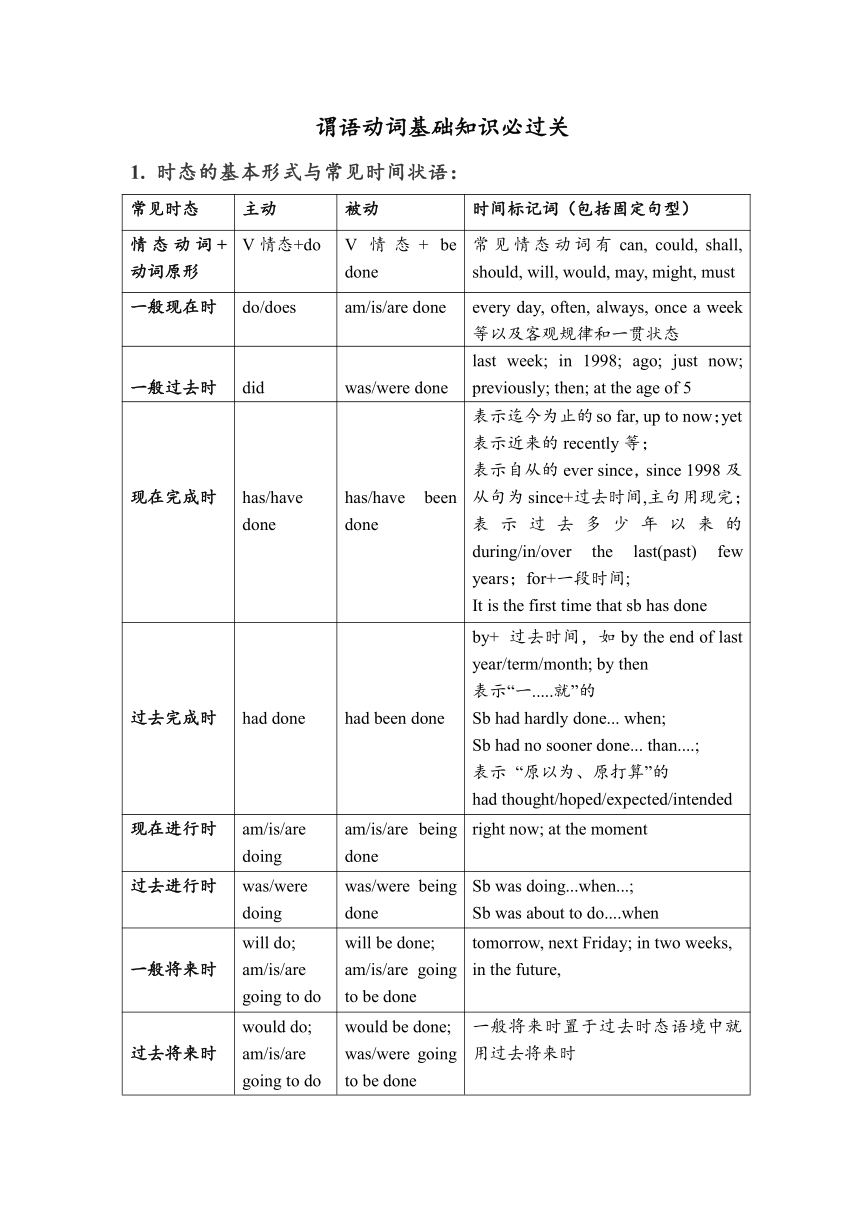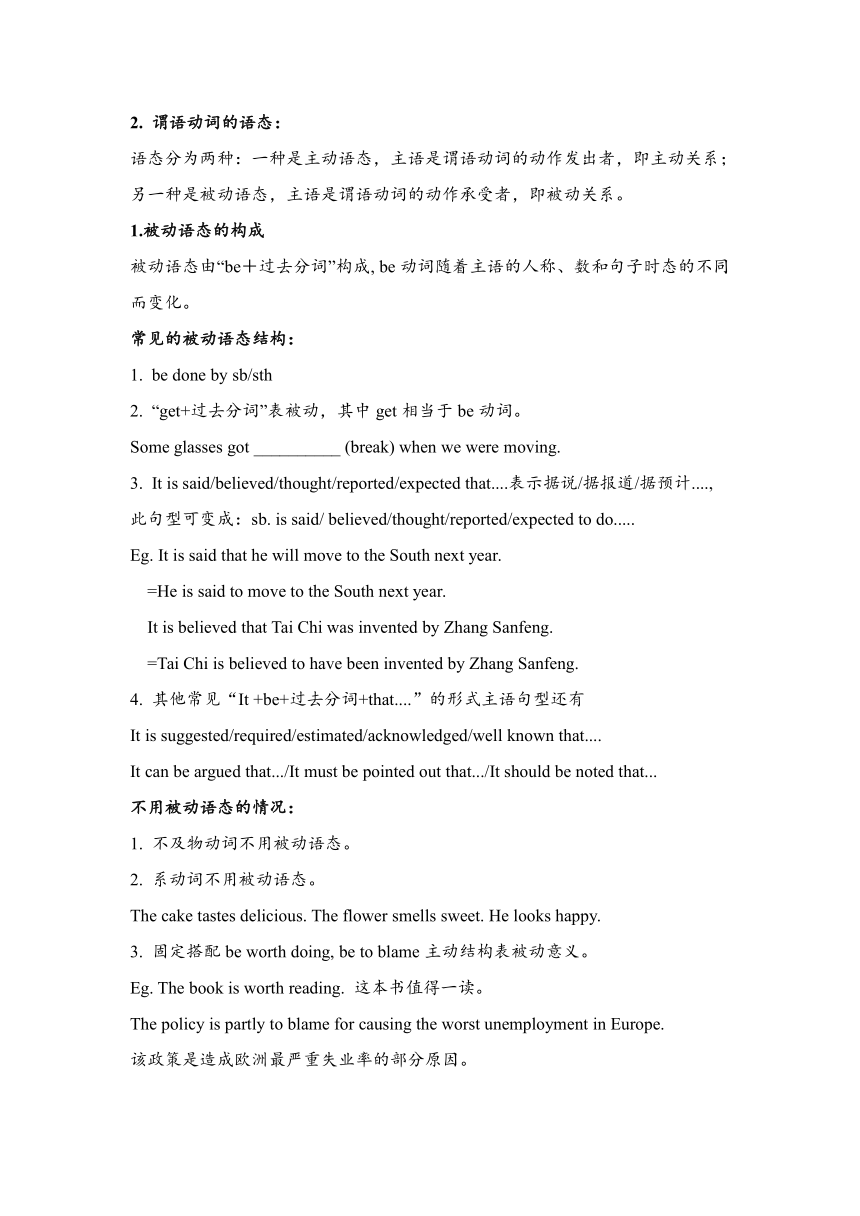谓语动词时态和变形基础知识 讲义-2025届高三英语二轮复习专项
文档属性
| 名称 | 谓语动词时态和变形基础知识 讲义-2025届高三英语二轮复习专项 |

|
|
| 格式 | docx | ||
| 文件大小 | 25.0KB | ||
| 资源类型 | 教案 | ||
| 版本资源 | 人教版(2019) | ||
| 科目 | 英语 | ||
| 更新时间 | 2024-12-27 12:01:51 | ||
图片预览


文档简介
谓语动词基础知识必过关
时态的基本形式与常见时间状语:
常见时态 主动 被动 时间标记词(包括固定句型)
情态动词+动词原形 V情态+do V情态+ be done 常见情态动词有can, could, shall, should, will, would, may, might, must
一般现在时 do/does am/is/are done every day, often, always, once a week等以及客观规律和一贯状态
一般过去时 did was/were done last week; in 1998; ago; just now; previously; then; at the age of 5
现在完成时 has/have done has/have been done 表示迄今为止的so far, up to now;yet 表示近来的recently等; 表示自从的ever since,since 1998及 从句为since+过去时间,主句用现完; 表示过去多少年以来的during/in/over the last(past) few years;for+一段时间; It is the first time that sb has done
过去完成时 had done had been done by+ 过去时间,如by the end of last year/term/month; by then 表示“一.....就”的 Sb had hardly done... when; Sb had no sooner done... than....; 表示 “原以为、原打算”的 had thought/hoped/expected/intended
现在进行时 am/is/are doing am/is/are being done right now; at the moment
过去进行时 was/were doing was/were being done Sb was doing...when...; Sb was about to do....when
一般将来时 will do; am/is/are going to do will be done; am/is/are going to be done tomorrow, next Friday; in two weeks, in the future,
过去将来时 would do; am/is/are going to do would be done; was/were going to be done 一般将来时置于过去时态语境中就用过去将来时
谓语动词的语态:
语态分为两种:一种是主动语态,主语是谓语动词的动作发出者,即主动关系;另一种是被动语态,主语是谓语动词的动作承受者,即被动关系。
1.被动语态的构成
被动语态由“be+过去分词”构成, be动词随着主语的人称、数和句子时态的不同而变化。
常见的被动语态结构:
be done by sb/sth
“get+过去分词”表被动,其中get相当于be动词。
Some glasses got __________ (break) when we were moving.
It is said/believed/thought/reported/expected that....表示据说/据报道/据预计....,
此句型可变成:sb. is said/ believed/thought/reported/expected to do.....
Eg. It is said that he will move to the South next year.
=He is said to move to the South next year.
It is believed that Tai Chi was invented by Zhang Sanfeng.
=Tai Chi is believed to have been invented by Zhang Sanfeng.
其他常见“It +be+过去分词+that....”的形式主语句型还有
It is suggested/required/estimated/acknowledged/well known that....
It can be argued that.../It must be pointed out that.../It should be noted that...
不用被动语态的情况:
不及物动词不用被动语态。
系动词不用被动语态。
The cake tastes delicious. The flower smells sweet. He looks happy.
固定搭配be worth doing, be to blame主动结构表被动意义。
Eg. The book is worth reading. 这本书值得一读。
The policy is partly to blame for causing the worst unemployment in Europe.
该政策是造成欧洲最严重失业率的部分原因。
谓语动词的主谓一致:
主谓一致是指句子谓语的变化形式由主语的人称和数的形式决定。主谓一致通常遵循三个原则:语法一致、意义一致和就近一致原则。
一、语法一致原则
语法一致是指主语的单复数决定谓语动词的单复数。 主语为单数名词或不可数名词时,谓语动词用单数形式;主语为复数名词时,谓语动词用复数形式。
考点1:单个动词不定式、动名词短语、从句作主语时,谓语动词用单数。
考点2:主语后面跟有with, along with, together with, as well as, including, except等结构时,谓语动词形式由主语的单复数决定,也就是说不受这些词组影响。
考点3:“a number of +可数名词”作主语时,谓语动词用复数形式;“the number of +可数名词”作主语时,谓语动词用单数形式。
二、意义一致原则
意义一致是指谓语动词不取决于主语的语法形式,而是由其意义决定。
考点1:定语从句中谓语动词的单复数取决于其先行词的单复数。
考点2: 分数/百分数+名词做主语时,谓语动词根据名词的单复数形式决定。
考点3:单复数同形的名词(如means, species)以及集体名词做主语时(如class,audience, family),根据具体语境表达的单复数含义来确定谓语动词的单复数。
考点4:数词以及表示距离、金额、时间、重量等名词(短语)作主语时,通常作为整体看待,谓语动词用单数形式。
考点5:“the + 形容词”表示一类人时,谓语动词用复数形式。这类词有the poor, the homeless, the blind, the disabled, the young, the injured/wounded, the dead等。 “the + 姓氏的复数形式”表示某一家人,其作主语时,谓语动词用复数形式。
就近一致
就近一致是指谓语动词的数要与其最近的主语在人称和数上保持一致。
考点1:在there be, here be, not...but..., not only ... but also ..., or, either ... or ..., neither ... nor ... 等连接的名词作主语时,谓语动词要和离它最近的主语保持一致。
考点2:完全倒装结构中,谓语动词的单复数应与其实际主语名词保持一致。如In front of the building ________ (be) some trees.
附录
动词第三人称单数变化规则
1)直接在动词后+s.
2)以 s, x, sh, ch, 接尾的动词+ es,如:fix—fixes;teach—teaches等。
3)以辅音+o 接尾的动词+ es,如:go—goes;do—does 等。
4)以辅音+y 接尾的动词变 y 为 i+es,如:study —studies;carry—carries等;
以元音+y 接尾的动词,直接+ s,如:employ—employs;pay—pays 等。
动词-ing形式变化规则
直接+ ing,如carry——carrying
2)以不发音的e结尾的动词,去e再+ ing,如write——writing;change-changing
3)以重读闭音节结尾,即以“辅+元+辅”结尾的动词,双写最后一个辅音字母,再+ ing。高中课标内的重读闭音节单词有 admit, ban, beg, begin, chat, clap, control, dip(蘸), dig, drag, drop, equip, forget, get, hug, infer, nod, occur, pat, permit, plan, prefer, quit, regret, rob, shop, sit, skip, sob, star, step, stop, swim, tap(轻叩;开发), trap, win, wrap, cut, fit, hit, let, put, set, shut
4) 特殊变形:
die——dying;lie——lying;tie(系)——tying
picnic(野炊)——picnicking;panic(惊慌)——panicking
agree——agreeing; see——seeing;flee(逃跑)——fleeing
动词-ed形式变化规则
直接+ed
2) 以不发音的e结尾的词直接+ d,如live-lived;hope-hoped
3) 以辅音字母+y结尾时,变 y为i,再+ ed,如study-studied;carry-carried
以元音字母+y结尾时,+ ed,如play-played;stay-stayed; enjoy-enjoyed
以重读闭音节(辅+元+辅)结尾的词,要双写最后的辅音字母,然后再+ed。
特殊变形(内容太多,见课本最后的单词变形表)
时态的基本形式与常见时间状语:
常见时态 主动 被动 时间标记词(包括固定句型)
情态动词+动词原形 V情态+do V情态+ be done 常见情态动词有can, could, shall, should, will, would, may, might, must
一般现在时 do/does am/is/are done every day, often, always, once a week等以及客观规律和一贯状态
一般过去时 did was/were done last week; in 1998; ago; just now; previously; then; at the age of 5
现在完成时 has/have done has/have been done 表示迄今为止的so far, up to now;yet 表示近来的recently等; 表示自从的ever since,since 1998及 从句为since+过去时间,主句用现完; 表示过去多少年以来的during/in/over the last(past) few years;for+一段时间; It is the first time that sb has done
过去完成时 had done had been done by+ 过去时间,如by the end of last year/term/month; by then 表示“一.....就”的 Sb had hardly done... when; Sb had no sooner done... than....; 表示 “原以为、原打算”的 had thought/hoped/expected/intended
现在进行时 am/is/are doing am/is/are being done right now; at the moment
过去进行时 was/were doing was/were being done Sb was doing...when...; Sb was about to do....when
一般将来时 will do; am/is/are going to do will be done; am/is/are going to be done tomorrow, next Friday; in two weeks, in the future,
过去将来时 would do; am/is/are going to do would be done; was/were going to be done 一般将来时置于过去时态语境中就用过去将来时
谓语动词的语态:
语态分为两种:一种是主动语态,主语是谓语动词的动作发出者,即主动关系;另一种是被动语态,主语是谓语动词的动作承受者,即被动关系。
1.被动语态的构成
被动语态由“be+过去分词”构成, be动词随着主语的人称、数和句子时态的不同而变化。
常见的被动语态结构:
be done by sb/sth
“get+过去分词”表被动,其中get相当于be动词。
Some glasses got __________ (break) when we were moving.
It is said/believed/thought/reported/expected that....表示据说/据报道/据预计....,
此句型可变成:sb. is said/ believed/thought/reported/expected to do.....
Eg. It is said that he will move to the South next year.
=He is said to move to the South next year.
It is believed that Tai Chi was invented by Zhang Sanfeng.
=Tai Chi is believed to have been invented by Zhang Sanfeng.
其他常见“It +be+过去分词+that....”的形式主语句型还有
It is suggested/required/estimated/acknowledged/well known that....
It can be argued that.../It must be pointed out that.../It should be noted that...
不用被动语态的情况:
不及物动词不用被动语态。
系动词不用被动语态。
The cake tastes delicious. The flower smells sweet. He looks happy.
固定搭配be worth doing, be to blame主动结构表被动意义。
Eg. The book is worth reading. 这本书值得一读。
The policy is partly to blame for causing the worst unemployment in Europe.
该政策是造成欧洲最严重失业率的部分原因。
谓语动词的主谓一致:
主谓一致是指句子谓语的变化形式由主语的人称和数的形式决定。主谓一致通常遵循三个原则:语法一致、意义一致和就近一致原则。
一、语法一致原则
语法一致是指主语的单复数决定谓语动词的单复数。 主语为单数名词或不可数名词时,谓语动词用单数形式;主语为复数名词时,谓语动词用复数形式。
考点1:单个动词不定式、动名词短语、从句作主语时,谓语动词用单数。
考点2:主语后面跟有with, along with, together with, as well as, including, except等结构时,谓语动词形式由主语的单复数决定,也就是说不受这些词组影响。
考点3:“a number of +可数名词”作主语时,谓语动词用复数形式;“the number of +可数名词”作主语时,谓语动词用单数形式。
二、意义一致原则
意义一致是指谓语动词不取决于主语的语法形式,而是由其意义决定。
考点1:定语从句中谓语动词的单复数取决于其先行词的单复数。
考点2: 分数/百分数+名词做主语时,谓语动词根据名词的单复数形式决定。
考点3:单复数同形的名词(如means, species)以及集体名词做主语时(如class,audience, family),根据具体语境表达的单复数含义来确定谓语动词的单复数。
考点4:数词以及表示距离、金额、时间、重量等名词(短语)作主语时,通常作为整体看待,谓语动词用单数形式。
考点5:“the + 形容词”表示一类人时,谓语动词用复数形式。这类词有the poor, the homeless, the blind, the disabled, the young, the injured/wounded, the dead等。 “the + 姓氏的复数形式”表示某一家人,其作主语时,谓语动词用复数形式。
就近一致
就近一致是指谓语动词的数要与其最近的主语在人称和数上保持一致。
考点1:在there be, here be, not...but..., not only ... but also ..., or, either ... or ..., neither ... nor ... 等连接的名词作主语时,谓语动词要和离它最近的主语保持一致。
考点2:完全倒装结构中,谓语动词的单复数应与其实际主语名词保持一致。如In front of the building ________ (be) some trees.
附录
动词第三人称单数变化规则
1)直接在动词后+s.
2)以 s, x, sh, ch, 接尾的动词+ es,如:fix—fixes;teach—teaches等。
3)以辅音+o 接尾的动词+ es,如:go—goes;do—does 等。
4)以辅音+y 接尾的动词变 y 为 i+es,如:study —studies;carry—carries等;
以元音+y 接尾的动词,直接+ s,如:employ—employs;pay—pays 等。
动词-ing形式变化规则
直接+ ing,如carry——carrying
2)以不发音的e结尾的动词,去e再+ ing,如write——writing;change-changing
3)以重读闭音节结尾,即以“辅+元+辅”结尾的动词,双写最后一个辅音字母,再+ ing。高中课标内的重读闭音节单词有 admit, ban, beg, begin, chat, clap, control, dip(蘸), dig, drag, drop, equip, forget, get, hug, infer, nod, occur, pat, permit, plan, prefer, quit, regret, rob, shop, sit, skip, sob, star, step, stop, swim, tap(轻叩;开发), trap, win, wrap, cut, fit, hit, let, put, set, shut
4) 特殊变形:
die——dying;lie——lying;tie(系)——tying
picnic(野炊)——picnicking;panic(惊慌)——panicking
agree——agreeing; see——seeing;flee(逃跑)——fleeing
动词-ed形式变化规则
直接+ed
2) 以不发音的e结尾的词直接+ d,如live-lived;hope-hoped
3) 以辅音字母+y结尾时,变 y为i,再+ ed,如study-studied;carry-carried
以元音字母+y结尾时,+ ed,如play-played;stay-stayed; enjoy-enjoyed
以重读闭音节(辅+元+辅)结尾的词,要双写最后的辅音字母,然后再+ed。
特殊变形(内容太多,见课本最后的单词变形表)
